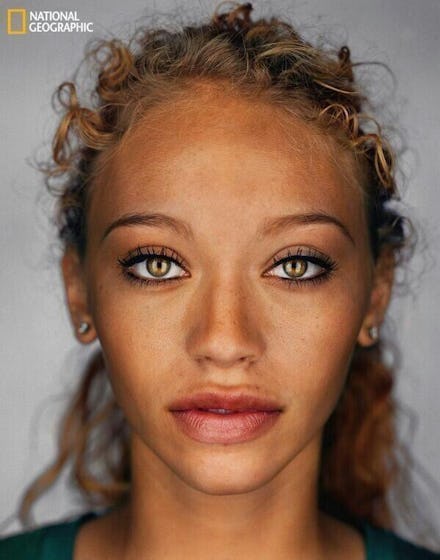National Geographic determined what Americans will look like in 2050, and it's beautiful

It's no secret that interracial relationships are trending upward, and in a matter of years we'll have Tindered, OKCupid-ed and otherwise sexed ourselves into one giant amalgamated mega-race.
But what will we look like? National Geographic built its 125th anniversary issue around this very question last October, calling on writer Lise Funderburg and Martin Schoeller, a renowned photographer and portrait artist, to capture the faces of our nation's multiracial future.
The images in the article are obviously not Photoshopped projections, but real people, meaning tomorrow's America lives among us now in every "Blackanese," "Filatino," "Chicanese" and "Korgentinian" you meet at the DMV, grocery store or wherever it is you hang out.
Their numbers will only grow. The U.S. Census Bureau let respondents check more than one race for the first time in 2000, and 6.8 million people did so. By 2010 that figure had increased to nearly 9 million, a spike of about 32%.
This is certainly encouraging, but there are obvious flaws with tracking racial population growth through a survey that lets people self-identify, especially since so many familial, cultural and even geographical factors influence your decision to claim one or multiple races. Complicating things further is the definition of race itself: It has no basis in biology, yet its constructions, functions and mythologies irrevocably shape the world as we know it.
So is an end approaching? Will increased racial mixing finally and permanently redefine how we imagine our racial identities? The latest figures suggest we're getting more comfortable with the idea, or perhaps that we simply give fewer shits than ever before. Either would be a step in the right direction.
The Wall Street Journal reported a few years back that 15% of new marriages in 2010 were between individuals of different races. It's unclear whether they've included same-sex unions in the count, but as currently stated, this number is more than double what it was 25 years ago. The proportion of intermarriages also varied by race, with "9% of whites, 17% of blacks, 26% of Hispanics and 28% of Asians [marrying] outside their ethnic or racial group." Interracial unions now account for 8.4% of all marriages in the U.S.
Image Credit: Wall Street Journal
In addition, more than 7% of the 3.5 million children born in 2009, the year before the 2010 census, were of two or more races.
The future: As for how this looks moving forward, studies have repeatedly shown that young people, especially those under 30, are significantly more amenable to interracial relationships than older adults, while college grads are more likely to have positive attitudes toward them than those with only a high school diploma. What does this mean for Millennials? As a population composed largely of over-educated 20-somethings, our generation is primed and expected to play a major role in populating this projected future America. That goes double if you live in a Western state, where people intermarry at higher rates; Hawaii is winning at the moment, with 4 of 10 new marriages identifying as interracial.
This doesn't mean it's all sunshine, rainbows and butterflies, however. Stark segregation still plagues many parts of the country. Poverty remains a barrier to social mobility and its consequent opportunities to interact with a diverse range of people. Sadly, the inequalities that shape American society as a whole are equally present in interracial relationship patterns. Time will tell if this holds for the long term.
But in the meantime, let us applaud these growing rates of intermixing for what they are: An encouraging symbol of a rapidly changing America. 2050 remains decades away, but if these images are any preview, it's definitely a year worth waiting for.
Editor’s Note: This article was updated on 12/17/19 to omit images that are no longer available to share.